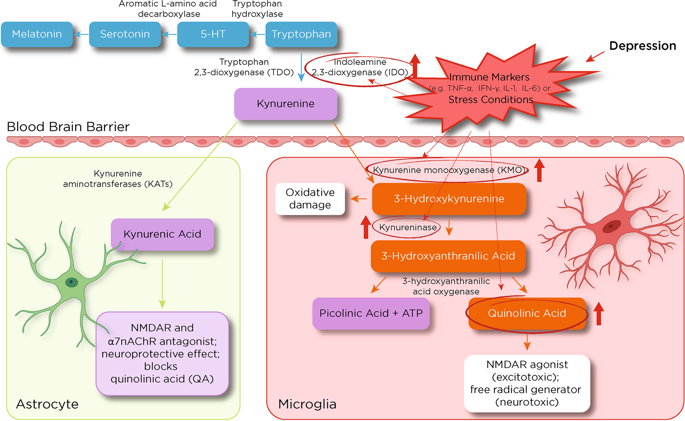当前位置:
X-MOL 学术
›
Mol. Psychiatry
›
论文详情
Our official English website, www.x-mol.net, welcomes your feedback! (Note: you will need to create a separate account there.)
The kynurenine pathway and bipolar disorder: intersection of the monoaminergic and glutamatergic systems and immune response.
Molecular Psychiatry ( IF 11.0 ) Pub Date : 2019-11-15 , DOI: 10.1038/s41380-019-0589-8 Bashkim Kadriu 1 , Cristan A Farmer 1 , Peixiong Yuan 1 , Lawrence T Park 1 , Zhi-De Deng 1 , Ruin Moaddel 2 , Ioline D Henter 1 , Bridget Shovestul 1 , Elizabeth D Ballard 1 , Cristoph Kraus 1 , Philip W Gold 3 , Rodrigo Machado-Vieira 1, 4 , Carlos A Zarate 1
Molecular Psychiatry ( IF 11.0 ) Pub Date : 2019-11-15 , DOI: 10.1038/s41380-019-0589-8 Bashkim Kadriu 1 , Cristan A Farmer 1 , Peixiong Yuan 1 , Lawrence T Park 1 , Zhi-De Deng 1 , Ruin Moaddel 2 , Ioline D Henter 1 , Bridget Shovestul 1 , Elizabeth D Ballard 1 , Cristoph Kraus 1 , Philip W Gold 3 , Rodrigo Machado-Vieira 1, 4 , Carlos A Zarate 1
Affiliation

|
Dysfunction in a wide array of systems-including the immune, monoaminergic, and glutamatergic systems-is implicated in the pathophysiology of depression. One potential intersection point for these three systems is the kynurenine (KYN) pathway. This study explored the impact of the prototypic glutamatergic modulator ketamine on the endogenous KYN pathway in individuals with bipolar depression (BD), as well as the relationship between response to ketamine and depression-related behavioral and peripheral inflammatory markers. Thirty-nine participants with treatment-resistant BD (23 F, ages 18-65) received a single ketamine infusion (0.5 mg/kg) over 40 min. KYN pathway analytes-including plasma concentrations of indoleamine 2,3-dioxygenase (IDO), KYN, kynurenic acid (KynA), and quinolinic acid (QA)-were assessed at baseline (pre-infusion), 230 min, day 1, and day 3 post-ketamine. General linear models with restricted maximum likelihood estimation and robust sandwich variance estimators were implemented. A repeated effect of time was used to model the covariance of the residuals with an unstructured matrix. After controlling for age, sex, and body mass index (BMI), post-ketamine IDO levels were significantly lower than baseline at all three time points. Conversely, ketamine treatment significantly increased KYN and KynA levels at days 1 and 3 versus baseline. No change in QA levels was observed post-ketamine. A lower post-ketamine ratio of QA/KYN was observed at day 1. In addition, baseline levels of proinflammatory cytokines and behavioral measures predicted KYN pathway changes post ketamine. The results suggest that, in addition to having rapid and sustained antidepressant effects in BD participants, ketamine also impacts key components of the KYN pathway.
中文翻译:

犬尿氨酸途径和双相情感障碍:单胺能和谷氨酸能系统与免疫反应的交集。
抑郁症的病理生理学涉及多种系统(包括免疫系统、单胺能系统和谷氨酸能系统)的功能障碍。这三个系统的一个潜在交叉点是犬尿氨酸 (KYN) 通路。本研究探讨了原型谷氨酸能调节剂氯胺酮对双相抑郁症 (BD) 患者内源性 KYN 通路的影响,以及对氯胺酮的反应与抑郁症相关行为和外周炎症标志物之间的关系。39 名患有难治性 BD 的参与者(23 F,年龄 18-65 岁)在 40 分钟内接受了单次氯胺酮输注(0.5 mg/kg)。KYN 通路分析物——包括吲哚胺 2,3-双加氧酶 (IDO)、KYN、犬尿酸 (KynA) 和喹啉酸 (QA) 的血浆浓度——在基线(输注前)、230 分钟、服用氯胺酮后第 1 天和第 3 天。实施了具有受限最大似然估计和稳健三明治方差估计的一般线性模型。使用时间的重复效应来模拟残差与非结构化矩阵的协方差。在控制了年龄、性别和体重指数 (BMI) 后,氯胺酮后 IDO 水平在所有三个时间点均显着低于基线。相反,与基线相比,氯胺酮治疗在第 1 天和第 3 天显着增加了 KYN 和 KynA 水平。氯胺酮后未观察到 QA 水平的变化。在第 1 天观察到较低的氯胺酮后 QA/KYN 比率。此外,促炎细胞因子和行为测量的基线水平预测了氯胺酮后 KYN 通路的变化。结果表明,
更新日期:2019-11-15
中文翻译:

犬尿氨酸途径和双相情感障碍:单胺能和谷氨酸能系统与免疫反应的交集。
抑郁症的病理生理学涉及多种系统(包括免疫系统、单胺能系统和谷氨酸能系统)的功能障碍。这三个系统的一个潜在交叉点是犬尿氨酸 (KYN) 通路。本研究探讨了原型谷氨酸能调节剂氯胺酮对双相抑郁症 (BD) 患者内源性 KYN 通路的影响,以及对氯胺酮的反应与抑郁症相关行为和外周炎症标志物之间的关系。39 名患有难治性 BD 的参与者(23 F,年龄 18-65 岁)在 40 分钟内接受了单次氯胺酮输注(0.5 mg/kg)。KYN 通路分析物——包括吲哚胺 2,3-双加氧酶 (IDO)、KYN、犬尿酸 (KynA) 和喹啉酸 (QA) 的血浆浓度——在基线(输注前)、230 分钟、服用氯胺酮后第 1 天和第 3 天。实施了具有受限最大似然估计和稳健三明治方差估计的一般线性模型。使用时间的重复效应来模拟残差与非结构化矩阵的协方差。在控制了年龄、性别和体重指数 (BMI) 后,氯胺酮后 IDO 水平在所有三个时间点均显着低于基线。相反,与基线相比,氯胺酮治疗在第 1 天和第 3 天显着增加了 KYN 和 KynA 水平。氯胺酮后未观察到 QA 水平的变化。在第 1 天观察到较低的氯胺酮后 QA/KYN 比率。此外,促炎细胞因子和行为测量的基线水平预测了氯胺酮后 KYN 通路的变化。结果表明,


























 京公网安备 11010802027423号
京公网安备 11010802027423号